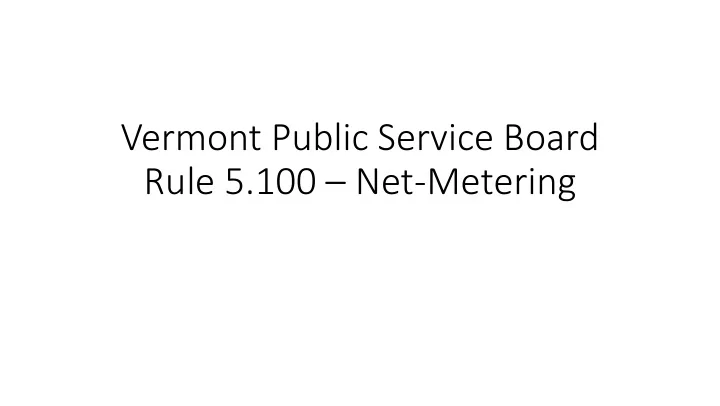

Vermont Public Service Board Rule 5.100 – Net-Metering
How Net-Metering Works Residential Photovoltaic Solar Example 1 Solar panels transform energy from the sun into electricity Excess energy produced from your solar panels is distributed back into the electric grid 2 Energy used in your home is An Inverter converts the electricity drawn from the electric grid produced by the solar panels from direct current (DC) to alternating current (AC) for use in your home. A 4 meter measures how much energy A bi-directional utility meter your system produces. measures energy used from the electric grid and excess energy produced from your solar panels 3 Energy is used to power your home
Net-Metering 1.0 • Program started in 1997 • Began with small systems and limited program size • Over time, the law allowed larger systems and increased the program’s capacity • In 2011, customers using solar were offered an incentive payment of ~5 cents per kilowatt-hour (kWh) • Monetization of credits began • Group systems became common • In 2014 Act 99 directed Board to start developing “Net - Metering 2.0” • In 2015 the program filled the statutory 15% capacity cap 3
Number of CPG Applications and Cumulative Program Capacity by Year 3500 200,000 180,000 3000 160,000 2500 140,000 Number of Applications 120,000 2000 kW 100,000 1500 80,000 60,000 1000 40,000 500 20,000 0 0 1999 2000 2001 2002 2003 2004 2005 2006 2007 2008 2009 2010 2011 2012 2013 2014 2015 2016 Number of Applications Cumulative Capacity
Recent Developments • Significant decreases in installation cost of solar • Development of competitive renewable energy markets in Vermont: Resource Price per kWh Notes Section 219a Net-Metering ~22 cents Utility does not receive Renewable Energy Certificate (“REC”) Large Scale Wind 8.8-11 cents Includes REC Energy Efficiency 4.4 cents Not electricity, no RECs Standard-Offer Solar 2.2 10-13 cents Utility receives REC Other Tier II Solar Resources ~12 cents Utility receives REC • Robust build-out of solar in Vermont and New England has changed the value of the benefits offered by building more solar 5
Increased solar deployment will push the time of the peak load to later in the day Source: https://www.iso-ne.com/static-assets/documents/2016/06/a8_isone_net_loads_with_increasing_behind_the_meter_pv.pdf 6
Structure of the Rule • Five Parts I. General Provisions II. Application Procedures III. Public Participation IV. Program Requirements (rates, billing, groups) V. Compliance Procedures
Summary of Significant Changes • Incentive structure • Incentives for better siting decisions • Incentives to support Vermont’s Renewable Energy Standard and reduce greenhouse gas emissions • Designed to reflect economies of scale and future changes in the cost of technology • Rate structure • Reduce the cost shift between net- metering customers and customers who don’t net-meter • Periodic review of incentives to reflect changes in technology and markets • Application Procedures • Designed to encourage better siting decisions • Designed to facilitate public participation in Board proceedings 8
Preferred Sites (Section 5.103) • Roofs • Parking lot canopies • Previously developed sites • Brownfields • Landfills • Gravel pits • Municipally designated site • Superfund sites • “Next to load” 9
Application Procedures • Registrations (Section 5.105) • Ground mounted solar up to 15 kW • Roof mounted solar up to 500 kW • Hydro up to 500 kW • “Application Form” (Section 5.106) • Any ground mounted system (solar, wind, biomass, CHP) over 15 kw and up to 50 kW • No hydro • “Petitions” (Section 5.107) • Everything over 50 kW, except hydro
Application and Petition Procedures 45-Day Advance Notice Filing Board Determines Application to be Complete • Prehearing Conference Application Notice • Site Visit • Discovery • Testimony & Exhibits 30-Day Comment Period, Requests • Evidentiary Hearing to Intervene, Requests for Hearing • Stipulation or MOU • Briefs Yes, then No, then Decision Decision
Part III – Public Participation • Part III is intended to provide guidance to the public about how to participate in the review of net-metering CPG applications 12
Pre-Existing Systems • Pre-existing systems are exempt from certain provisions of the rule: • Pre-existing systems continue to receive the rates provided by Section 219a for 10 years • Pre-existing systems are not subject to non-bypassable charges for 10 years • Pre-existing systems are not subject to REC or siting adjustors • Pre-existing systems will receive the blended residential rate for excess generation after 10 years 13
Rate Structure • New rate structure can be described as “retail plus” or “retail minus” depending on the system • To calculate the value of a net-metering credit, start with the “Blended Residential Rate” • Company’s general residential service rate, • Blend of company’s residential block rates, or • Statewide average rate (14.9 cents)
Siting and REC Adjustors Siting Adjustor REC Adjustor Type of Project Adjustor Value Transfer REC to utility +3 cents per kWh < 15 kW 1 cent per kWh Customer retains REC -3 cents per kWh 15 – 150 kW 1 cent per kWh “well sited” 15-150 kW (-3) cent per kWh “greenfield” 150 – 500 kW (-1) cents per kWh “well sited” Hydroelectric facilities 0 cents per kWh
Examples of rates available to net-metering systems All values in cents per kWh. Type of Net-Metering System Blended Siting Positive or Total with either residential adjustor negative REC positive or negative rate adjustors REC adjustor 14.9 1 3 or (-3) 18.9 or 12.9 < 15 kW 14.9 1 3 or (-3) 18.9 or 12.9 15 – 150 kW “well sited” 14.9 (-3) 3 or (-3) 14.9 or 8 .9 15-150 kW “greenfield” 14.9 (-1) 3 or (-3) 16.9 or 10.9 150 – 500 kW “well sited” 16
Non Non-Bypassable Charges Highlighted items are non-bypassable Total non-bypassable charges for this bill are $22.99 17
Part IV – Compliance Procedures • Section 5.134 establishes procedures for enforcement of CPG conditions 18
Recommend
More recommend